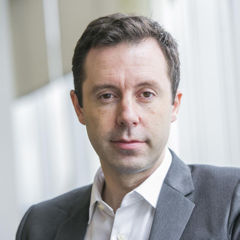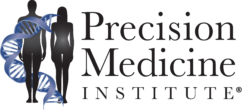Editor’s note: For up-to-the minute insights from the nation’s first movers and early adopters in the field of precision medicine, the Precision Medicine Institute Symposium 2019 is taking place Thursday and Friday, May 2-3, at the Sheraton Hotel in New Orleans. Visit https://www.precisionmedicineforhospitals.com to learn more and to register.
Olivier Elemento, PhD, holds advanced degrees in mechanical engineering, artificial intelligence (AI), and computational biology, fields he says he pursued by following his curiosity and passion for learning. Today, as director of the Englander Institute for Precision Medicine at Weill Cornell Medicine, he’s on the frontier of bringing discoveries about the human genome out of the lab and into clinical care.
As a presenter at this year’s Precision Medicine Institute Symposium, Elemento, also a Weill Cornell professor, will share the latest findings in how whole exome sequencing, whole genome sequencing, and AI are transforming oncology and cancer care. But more important than the examples he plans to share of such advances being made at Weill Cornell, Elemento says he hopes to convey a broader message about what this work will mean for medicine and patient care.
“I will make it clear that I think the future of genomic medicine is very bright because we’re starting to understand the human genome in a lot of detail,” he says. “While there’s still a lot to do, the time has come now to think hard about broad integration of genomics into medicine.”
But for genomic medicine to reach its potential, it will take more than uncovering additional actionable insights within the human genome, Elemento says. It will take an industrywide change in mindset linked to some of the same principles that Elemento instills in his students.

Olivier Elemento, PhD, is the director of the Englander Institute for Precision Medicine. He is also an associate professor in the department of physiology and biophysics, the associate director of the Institute for Computational Medicine, director of the Laboratory of Cancer Systems Biology, co-leader of the Genetics, Epigenetics, and Systems Biology Program in the Meyer Cancer Center at Weill Cornell Medicine, and associate professor in the department of physiology and biophysics. O
1. Persistence
“It’s critical that we educate the next generation not just about cutting-edge science, but also teach them the principles of being a good scientist,” Elemento says. These traits include curiosity, objectivity, patience, and perseverance.
At Weill Cornell, that dogged persistence led it to become one of the first healthcare centers in the United States to have integrated genomics into the medical record for cancer patients. “We’ve had some successes in that space, but it wasn’t easy—because the medical software used by most centers is not really meant to enable easy integration,” he says. “We had to really come to understand the software in a lot of detail, as well as the interfaces and the language of the software, to allow integration.”
Another ongoing example of tenacity is the work Elemento and his team are doing to predict the most effective therapies for patients with advanced cancer. The Exome Cancer Test (EXaCT)-1, developed in 2016, involves sequencing both tumor and matched constitutional DNA to distinguish somatic mutations in the tumor from background germline mutations, and can detect genomic alterations driving specific tumors. A prospective analysis of 337 cancer cases found mutations in clinically relevant genes in 82 percent of the tumors, demonstrating the test is an accurate method for identifying actionable mutations.
The work hasn’t stopped there. The forthcoming EXaCT-2 combines broad exome sequencing with targeted deeper sequencing of dozens of highly actionable genes, specific promoters, and viral sequences.
2. Convergence of Tools
While it may seem that biology and computer science represent entirely different fields, the introduction of computers and AI into healthcare can be, perhaps more accurately, described as a progression enabled by an expanded toolkit.
“There’s a convergence of different tools now. Where it used to be that the tools of a biologist were the microscope and pipette, now [we have] access to computers and computer programming and so on,” Elemento says. “The way I view these tools is exactly the same as a microscope and pipette. They are additional tools every biologist should be able to master as a way to enable hypothesis- and data-driven science.”
For healthcare organizations, this perspective can be helpful when considering adoption of precision medicine as well as AI. Adoption does not require abandonment of traditional medicine, but it does require deepening and expanding one’s ability to provide patient care.
For example, researchers at Weill Cornell Medicine and NewYork-Presbyterian developed an AI program that can distinguish types of cancer from images of cells with almost 100 percent accuracy, according to a study released last year.
“The neural network can do a lot of work for pathologists,” said Elemento in a news release. “It can pick up patterns that are very hard for even highly-trained experts to see. But we still need humans to interpret the data and communicate with patients and their treating physicians. Our hope is that this technology makes pathologists more productive and more accurate.”
3. Long-range Vision
“We have a vision of how genomics and AI will be part of medicine, and we’re not there yet,” Elemento says. “We have quite a bit of work to do to better understand the genome, for example, to make it as actionable as possible. Now there’s only a fraction of the genome that’s actionable, but I would like to establish a road map to where we’re going, or where we think we should be going.”
Aspects of that vision that seem distant now, namely a more thorough understanding of the genome, can be incorporated into the work of today. For example, the philosophy behind sequencing the entirety of a person’s genome—and then putting that data into the medical record—holds the idea that the information will be available years later when more answers about what it means are available.
“In the past two to five years, we’ve come to realize that there’s a lot of interesting stuff not just in the genes but between them, including switches that turn on and off genes, as well as mutations that we don’t necessarily understand but know are connected to disease,” Elemento says.
With whole genome sequencing, this potentially useful information can be captured without having to re-sequence later, he explains. “The goal is to save a lot of resources and money later by doing it this way now.”
—Debra A. Shute
Related Information:
Artificial Intelligence Aids in Cancer Diagnosis
News from Englander Institute for Precision Medicine
Preparing Hospital CEOs for Success with Precision Medicine
Making Personalized Medicine a Reality for More Patients with Cancer
